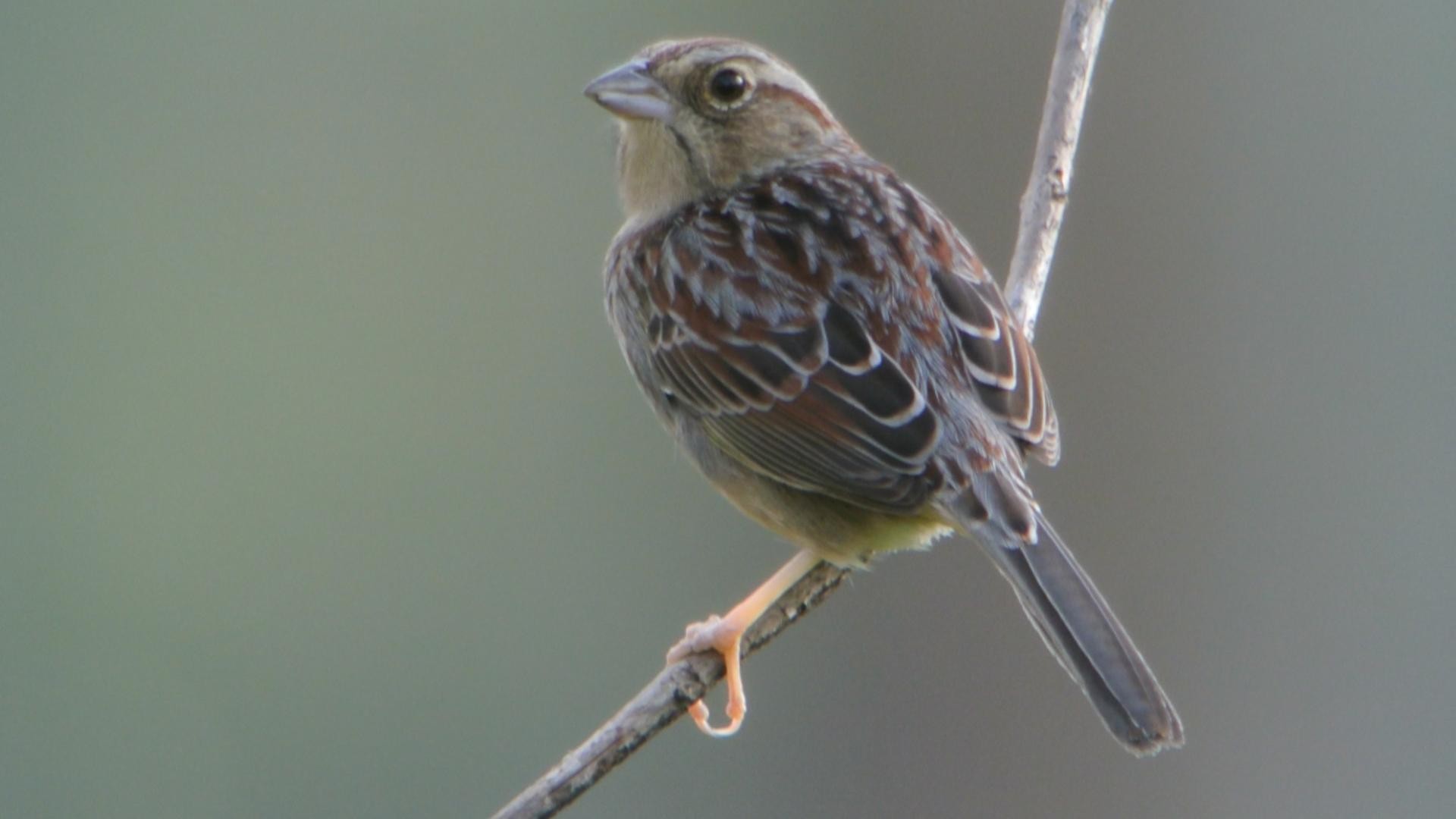Bachman's Sparrow
A species of Sparrow Scientific name : Peucaea aestivalis Genus : Sparrow
Bachman's Sparrow, A species of Sparrow
Botanical name: Peucaea aestivalis
Genus: Sparrow
 Photo By Andy Reago & Chrissy McClarren , used under CC-BY-2.0 /Cropped and compressed from original
Photo By Andy Reago & Chrissy McClarren , used under CC-BY-2.0 /Cropped and compressed from original Description
Bachman's sparrow (Peucaea aestivalis) is a small American sparrow that is endemic to the southeastern United States. This species was named in honor of Reverend John Bachman. Adults have rufous brown upperparts and crown with gray and black streaking on the nape, back and primaries. The face is gray with a rufous brown eyestripe. It has a buff colored breast and whitish belly. These are mid-sized New World sparrows, measuring 12.2–16.2 cm (4.8–6.4 in) and weighing 18.4–23 g (0.65–0.81 oz). Their breeding habitat is open pine forests. The domed nest is usually built on the ground near a clump of grass or a bush. Females lay three to five eggs. Bachman's sparrow is primarily a non-migratory resident, but it may retreat from some of the most northerly territories. The species is mainly a granivore, but it will also take some insects. This bird is considered near threatened by the IUCN, with habitat loss one of the major factors often cited in its decline. Habitat degradation due to later stages of forest succession has also been attributed to the decline of this species. Prescribed forest burns may assist in recovery. The song begins as a clear whistle, followed by a short trill. 
Size
15 cm (6 in)
Life Expectancy
3-3.9 years
Nest Placement
Ground
Clutch Size
2 - 5 eggs
Incubation Period
1 - 2 broods
Number of Broods
12 - 14 days
Nestling Period
9 - 10 days
Feeding Habits
Bachman's Sparrow predominantly forages on the ground, consuming a diet mainly composed of seeds, with a preference for those from Panicum grasses, and various insects.
Habitat
Bachman's Sparrow thrives in open pine woodlands, particularly those dominated by Longleaf Pine interspersed with native grasses like wiregrass and saw palmetto. They favor habitats with a sparse understory, minimal shrub density, and an open structure maintained by regular fire regimes. These birds are found in relatively dry environments, from lowland pine savannas to limestone glades, as well as in disturbed areas such as utility rights-of-way, roadcuts, and young clearcuts. They avoid dense forests and areas that have not been subject to fire for prolonged periods, typically more than four years.
Nest Behavior
Bachman's Sparrow females commence nest-building by creating a scrape, followed by cup construction with local materials. The breeding season prompts egg laying, and both parents engage in the nurturing of the eggs and subsequent young.
Nest Characteristics
Bachman's Sparrow's nests are ground-based, usually at the base of shrubs or pine seedlings, and domed due to overhead vegetation coverage. The cup-shaped nests are woven from grasses, rootlets, and other plants, occasionally elevated slightly above ground.
Dite type
Granivorous
Migration Overview
Reviews and a field guide summarize the limited information available on Bachman's sparrow migration. Bachman's sparrows in the southern portion of their range are resident, while those in Missouri, Arkansas, eastern Oklahoma, Tennessee, Virginia, parts of North Carolina, and extreme northern Mississippi and Alabama have been thought to migrate south during winter. Historical records suggest that Bachman's sparrows that once bred from Illinois to Pennsylvania did migrate to the south. Records of Bachman's sparrow occurrence on breeding grounds and specimens of subspecies collected outside their normal breeding range suggest that spring migration occurs from mid-March to May and fall migration occurs from late August through to late October. However, migration of Bachman's sparrows in the northern part of their current range is not well understood and it may be that suitable habitat conditions do no necessitate migration. Because of their secretive nature, determining the presence of Bachman's sparrows is difficult outside of the breeding season, when individuals rarely sing and perch visibly. However, examination of eBird data from recent decades suggests that several populations of Bachman's sparrows remain in North Carolina for the winter. 
General Info
Feeding Habits
Bird food type
Bird Feeder Type

Platform
Behavior
Bachman's Sparrow predominantly forage by walking and hopping on the ground in search of seeds and insects. They exhibit an apparent preference for running over flying, which, when necessary, is characterized by a labored flight with distinctive tail pumping. Males exhibit territorial behaviors, including wing quivering and bouncing, to ward off rivals. These birds typically engage in monogamous relationships, often remaining in pairs or small family units throughout the year.
Distribution Area
Bachman's sparrows occur primarily in the southeastern United States from the central region of peninsular Florida north to southeastern North Carolina and west through portions of Tennessee, Kentucky and Missouri to eastern Oklahoma and eastern Texas. Following forest conversion and the spread of agricultural fields up into the early 1900s, Bachman's sparrows rapidly expanded their range and began breeding in Illinois, Indiana, Ohio, West Virginia, Virginia, Maryland, and parts of Pennsylvania. However, this trend reversed during the 1930s as much of the eastern deciduous forest recovered. Bachman's sparrows are thought to have been extirpated from Virginia in the early 2000s, and North Carolina is now the northern periphery of their eastern range. Among the three subspecies of Bachman's sparrow, Peucaea aestivalis aestivalis breeds furthest east, from southeast South Carolina to peninsular Florida. Peucaea a. bachmanii occurs west of P. a. aestivalis to Mississippi and north to Kentucky. P. a. illinoensis occurs in the westernmost region of the species' range. 
Species Status
Not globally threatened.

 Photo By Andy Reago & Chrissy McClarren , used under CC-BY-2.0 /Cropped and compressed from original
Photo By Andy Reago & Chrissy McClarren , used under CC-BY-2.0 /Cropped and compressed from original Scientific Classification
Phylum
Chordates Class
Birds Order
Perching birds Family
New world sparrows Genus
Sparrow Species
Bachman's Sparrow